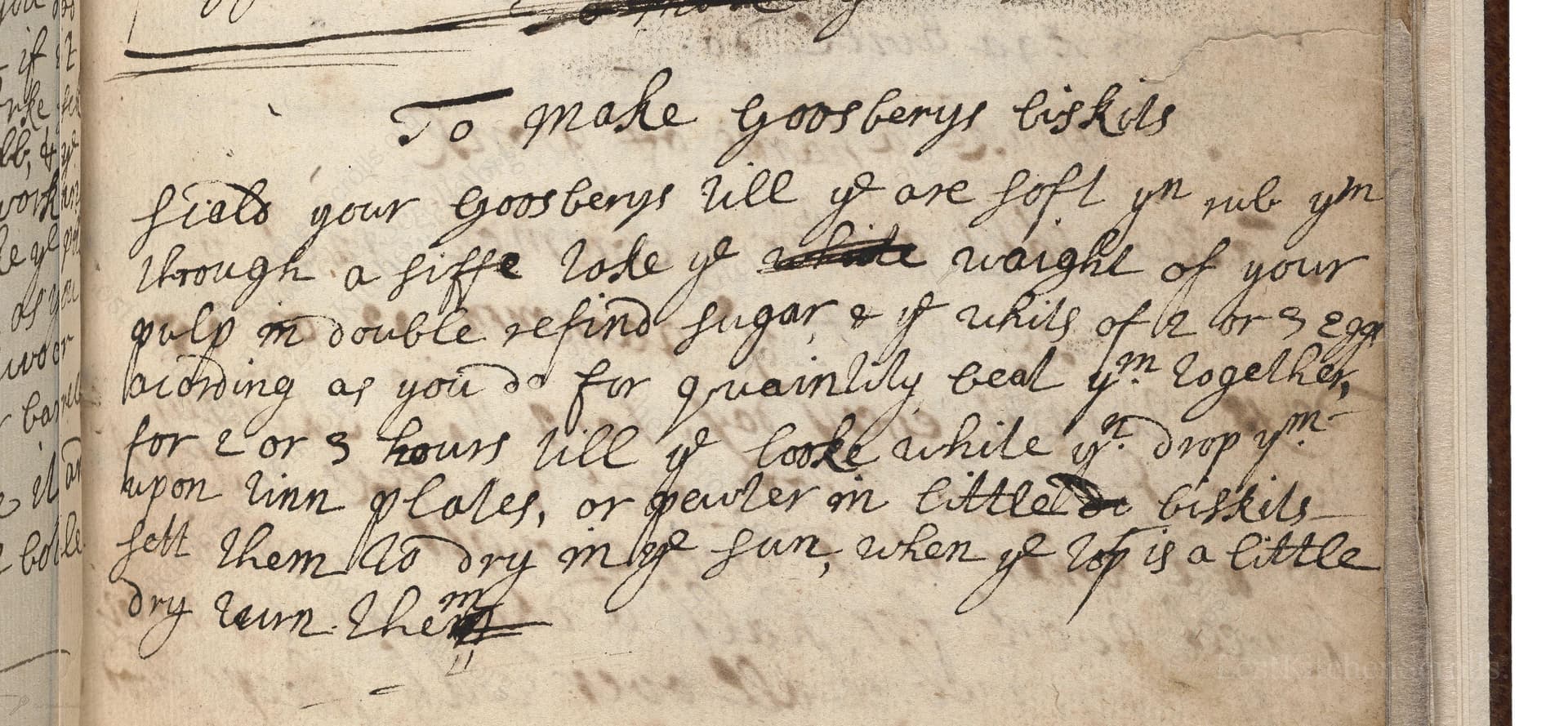To Make Goosberys Biskits
From the treasured pages of Cookery book of Lettice Pudsey, Seisdon, Staffordshire
Written by Lettice Pudsey

To Make Goosberys Biskits
"scald your goosberys till ye are soft, yn rub ym through a sisse take ye same waight of your pulp in double refind sugar & ye whits of 2 or 3 eggs acording as you do for quantity beat ym together for 2 or 3 hours till ye look white yn drop ym upon tinn plates, or pewter on little biskits lett them so dry in ye sun, when ye top is a little dry turn them"
Note on the Original Text
The recipe is written in highly abbreviated, phonetic 17th-century English. Common usages include 'scald' for gently cooking, 'sisse' (sieve), 'yn' (then), 'ym' (them), and 'ye' (the or you), reflecting both older spelling conventions and dialect. Instructions lack exact timings, temperatures, or quantities, assuming a cook's familiarity and adaptability. Whisking 'for 2 or 3 hours' highlights both the lack of modern equipment and the importance of labor in producing refined confections.

Title
Cookery book of Lettice Pudsey, Seisdon, Staffordshire (1675)
You can also click the book image above to peruse the original tome
Writer
Lettice Pudsey
Era
1675
Publisher
Unknown
Background
Step into the 17th-century kitchen with Lettice Pudsey's delightful collection of recipes, where flavors, creativity, and tradition mingle to create a feast fit for Restoration-era tables. Expect a medley of hearty English fare, intriguing ingredient combinations, and a pinch of culinary wisdom from a bygone age.
Kindly made available by
Folger Shakespeare Library
This recipe hails from late 17th-century England, attributed to Lettice Pudsey around 1675. It reflects a time when sugar was an expensive luxury and often used in impressive, labor-intensive confections to showcase both wealth and culinary skill. Gooseberries were a common English fruit, valued for their tartness and used in both savory and sweet dishes. Preserving fruit in meringue-like forms allowed for a delicate treat that lasted beyond gooseberry season.

Preparation would have required a brass or copper pan for scalding the gooseberries over a hearth fire, followed by pushing the fruit through a coarse sieve with a wooden spoon. The mixture would be beaten by hand, often with a large whisk or bundle of twigs, for up to several hours. To shape the biskits, cooks used tin or pewter plates, dropping the mixture in small rounds (sometimes onto small biscuits as a base). Drying was achieved by setting the plates in full sunlight, or near the gentle heat of a warm hearth, turning the confections as they started to harden.
Prep Time
25 mins
Cook Time
2 hrs 10 mins
Servings
12
We've done our best to adapt this historical recipe for modern kitchens, but some details may still need refinement. We warmly welcome feedback from fellow cooks and culinary historians — your insights support the entire community!
Ingredients
- 1 lb (16 oz) fresh gooseberries (or substitute with green grapes for a milder flavor)
- Equal weight of caster sugar (e.g., 10 oz gooseberry pulp to 10 oz sugar)
- 2–3 egg whites (from large eggs, about 2 oz total)
- Plain small biscuits (optional, as a base for each biskit)
Instructions
- Begin by gently simmering approximately 1 lb (16 oz) of fresh gooseberries in a saucepan with just enough water to cover, until they are soft but not falling apart (about 10 minutes).
- Once softened, push the gooseberries through a fine mesh sieve to extract the pulp, discarding skins and seeds.
- Weigh the resulting pulp and mix in an equal amount (by weight) of double refined caster sugar—so, for 10 oz of pulp, use 10 oz of sugar.
- Add in the whites of 2 to 3 large eggs, depending on your batch size.
- Whisk the mixture vigorously—preferably using an electric mixer—until it turns pale, glossy, and forms soft peaks (this will take 10-15 minutes, or up to 2 hours by hand as described historically!).
- Drop spoonfuls of this meringue-like mixture onto parchment-lined baking trays, optionally placing each dollop on a small round of plain biscuit.
- Let them air-dry in a warm place or low oven (140–175°F) until the tops are dry to touch, then gently turn them over to finish drying on the underside.
- They should be crisp and dry throughout.
Estimated Calories
90 per serving
Cooking Estimates
You need about 10 minutes to cook the gooseberries. Preparing the fruit, mixing ingredients, and whisking the mixture by electric mixer will take about 25 minutes. Drying the biscuits in a low oven takes 2 hours, but most of this is hands-off time. Each serving has about 90 calories. This recipe makes around 12 biscuits.
As noted above, we have made our best effort to translate and adapt this historical recipe for modern kitchens, taking into account ingredients nowadays, cooking techniques, measurements, and so on. However, historical recipes often contain assumptions that require interpretation.
We'd love for anyone to help improve these adaptations. Community contributions are highly welcome. If you have suggestions, corrections, or cooking tips based on your experience with this recipe, please share them below.
Join the Discussion
Rate This Recipe
Dietary Preference
Main Ingredients

Den Bockfisch In Einer Fleisch Suppen Zu Kochen
This recipe hails from a German manuscript cookbook compiled in 1696, a time whe...

Die Grieß Nudlen Zumachen
This recipe comes from a rather mysterious manuscript cookbook, penned anonymous...

Ein Boudain
This recipe comes from an anonymous German-language manuscript cookbook from 169...

Ein Gesaltzen Citroni
This recipe, dating from 1696, comes from an extensive anonymous German cookbook...
Browse our complete collection of time-honored recipes



